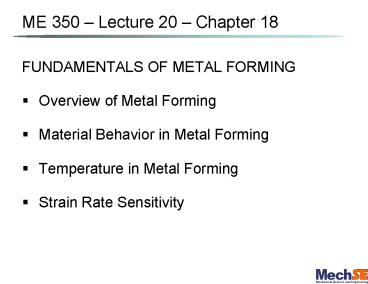FUNDAMENTALS OF METAL FORMING - PowerPoint PPT Presentation
1 / 16
Title:
FUNDAMENTALS OF METAL FORMING
Description:
ME 350 Lecture 20 Chapter 18 FUNDAMENTALS OF METAL FORMING Overview of Metal Forming Material Behavior in Metal Forming Temperature in Metal Forming – PowerPoint PPT presentation
Number of Views:1668
Avg rating:3.0/5.0
Title: FUNDAMENTALS OF METAL FORMING
1
ME 350 Lecture 20 Chapter 18
- FUNDAMENTALS OF METAL FORMING
- Overview of Metal Forming
- Material Behavior in Metal Forming
- Temperature in Metal Forming
- Strain Rate Sensitivity
2
Metal Forming
- Plastic deformation that changes the shape of a
metal workpiece using a tool, called a die, by
applying a stress that exceeds the metals
yield strength - Stresses are typically compressive
- Examples rolling, forging, extrusion
- However, some forming processes
- Stretch the metal (tensile stresses) wire
drawing - Others bend the metal (tensile and compressive)
- Still others apply shear
3
Basic Types of Deformation Processes
- Bulk deformation starting material has low
surface area to volume (e.g. billets bars) - Rolling
- Forging
- Extrusion
- Wire and bar drawing
- Sheet metalworking starting material has high
surface area to volume (e.g. sheet coils) - Bending
- Deep drawing
- Cutting
4
Rolling Forging
Extrusion Wire and Bar Drawing
5
Sheet Metalworking
- Often called pressworking
- Parts are often called stampings
- Usual tooling punch and die
Bending Cutting
6
Material Behavior in Metal Forming
- Plastic region of stress-strain curve is of
primary interest because material is plastically
deformed - In plastic region, metal's behavior is expressed
by the flow curve
- where K strength coefficient and n strain
hardening exponent (typical material values
listed in Table 3.4) - Flow curve based on true stress and true strain
7
Flow Stress Average Flow Stress
- Flow stress, Yf, - the instantaneous (or maximum)
stress required to continue deforming the
material. (used in upset or impression forging) - Average flow stress, Yf, - integrating area under
the stress curve . (? maximum strain during
deformation, used in open forging, rolling or
drawing)
8
Temperature in Metal Forming
- K and n in the flow curve depend on temperature
- At higher temperatures ductility is increased
- At higher temperatures both K and n are
reduced - Thus, the force and power required to perform
deformation operations at elevated temperatures
are lower - Three temperature ranges in metal forming
- Cold working
- Warm working
- Hot working
9
Cold Working
- Temperature performed at room temp
- Advantages
- Better accuracy, closer tolerances
- Due to strain hardening, strength and hardness
are increased - Directional properties in workpart due to grain
flow - No heating of work required
- Disadvantages
- Metal may not be ductile enough for large
deformations - Deformation forces and power are higher
- Surfaces must be clean - free of scale and dirt
10
Warm Working
- Temperature between room and recrystallization
temperature ( 0.3Tm in Kelvin) - Advantages
- Lower forces and power than cold working
- More intricate work geometries possible
- Need for annealing may be reduced or eliminated
11
Hot Working
- Temperature at or above the recrystallization
temperature ( 0.5 Tm in Kelvin) - Advantages
- Large deformations possible (fracture and
cracking possibility eliminated or greatly
reduced) - Lower forces and power required
- Strength properties of product are generally
isotropic - Disadvantages
- Lower dimensional accuracy
- Higher total energy required (due to heating)
- Work surface oxidation (scale), poorer surface
finish - Shorter tool life
12
Strain Rate Sensitivity
- Theoretically, a metal in hot working behaves
like a perfectly plastic material, with strain
hardening exponent n 0 - The metal should continue to flow at the same
flow stress, once that stress is reached - However, an additional phenomenon occurs during
deformation, especially at elevated temperatures,
where larger stress is needed as deformation
velocity increases.
13
What is Strain Rate?
- Strain rate in forming is directly related to
speed of deformation, v (i.e. ram velocity) - where h instantaneous workpiece height
- As strain rate increases, resistance to
deformation increases
14
Strain Rate Sensitivity
- where C strength constant (similar but not
equal to strength coefficient in flow curve
equation), and m strain-rate sensitivity
exponent
15
Effect of Temperature on Flow Stress
where C, is the intersection of each plot with
the vertical dashed line at strain rate 1.0,
and m is the slope of each plot.
- Observations
- Increasing temp. C decreases
- Increasing temp. m increases
- Effect of strain rate at room temperature is
negligible
16
Quotes
- The more a person knows, the more they forgive. -
Confucius - Living well and beautifully and justly are all
one thing.- Socrates - Adversity introduces a person to themselves.
- And in the end, it's not the years in your life
that count. It's the life in your years.-
Abraham Lincoln - Beware the barrenness of a busy life. - Socrates

